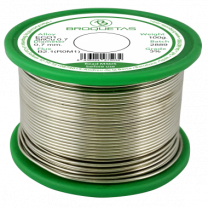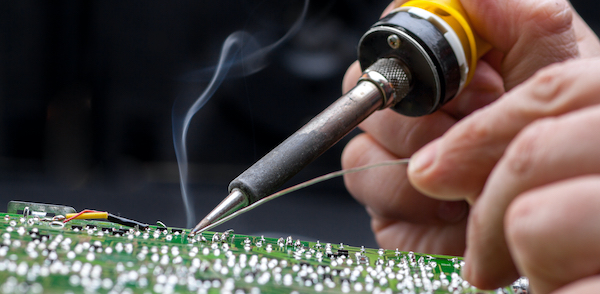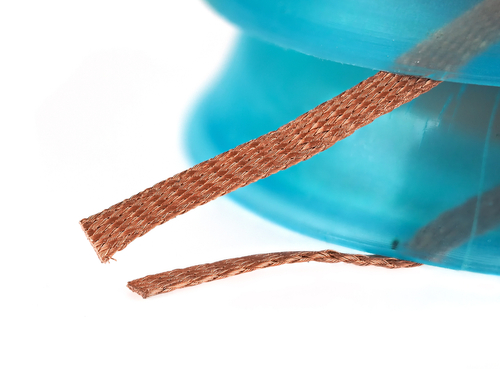Solder Material and Type Guide

Figure 1: Solder wire
Solder is an alloy with a low melting point; it permanently bonds two or more metal surfaces. There are various types of solders available, such as lead-based, lead-free, and silver-based, each with its unique properties and benefits. Choosing the appropriate solder type and flux is essential to ensure that the joint is strong, durable, and long-lasting. This article explores the different types of solder, their features, and their applications.
Table of contents
Types of solder
Understanding the various types of solder and their properties is important to ensure that the solder joint can withstand the environmental and mechanical stresses to which it will be exposed to.
- In applications where the joint will be subjected to high temperatures, it is crucial to choose a solder with a high melting point to prevent the joint from melting or weakening. For example, silver solder has a melting point between 630 𐩑C to 825 𐩑C (1136 - 1517 𐩑F), and it is commonly used in high-temperature applications.
- Applications that require high-strength joints, such as in aerospace or automotive industries, would require solders with higher tensile and shear strength, like tin-lead solder.
- For applications that involve delicate electronic components, low-temperature solders with low melting points (like bismuth-tin solder and indium solder) are preferred to prevent heat damage.
By selecting the right type of solder, you can ensure a strong, reliable, and long-lasting connection that will meet the specific requirements of your application.
Lead-based solder
Lead-based solder contains lead as one of its primary components. Tin-lead solder, the most common lead solder, contains approximately 60% tin and 40% lead. Tin is added for its lower melting point. Additionally, lead prevents tin whisker growth (small, hair-like protrusions called whiskers grow from the surface of tin, leading to short circuits). Lead solder has been widely used in various applications, including electronics, plumbing, and metalworking.
-
Advantages:
- Lower melting point compared to lead-free types
- Flows well (the solder readily spreads and adheres to the surfaces being soldered, forming a smooth and uniform joint)
- Easier to work with
- Quicker to bring to a working temperature
- Low cost
-
Disadvantages:
- Due to concerns about the potential health risks associated with lead exposure, many countries have banned or restricted the use of lead solder in certain applications, particularly those that involve drinking water or food. In many cases, lead-free alternatives are now being used.
Lead-free solders
The EPA (Environmental Protection Agency) has established regulations for using lead-free pipes, fittings, fixtures, solder, and flux for drinking water requiring no more than 0.2% lead when used with respect to solder and flux. Lead-free solder typically contains a combination of metals such as tin, copper, silver, and sometimes small amounts of other metals.
- Advantages: The use of lead-free solder has many benefits, including reduced environmental impact and improved safety for workers who handle the solder. Additionally, many countries have regulations that require the use of lead-free solder in certain applications, particularly those related to drinking water or food.
- Disadvantages: One of the challenges with lead-free solder is that it often requires higher melting temperatures than lead-based solder. This can make it more challenging to work with, as it can cause damage to electronic components if not used correctly. Additionally, lead-free solder may have slightly different physical and mechanical properties than lead-based solder, affecting its suitability for certain applications.
Flux core solder
Flux core solder contains a flux core inside the solder wire. Flux is a material that helps to clean and prepare the metal surfaces to be joined by removing oxides, contaminants, and other impurities. It also helps to facilitate the flow of molten solder by reducing surface tension and preventing oxidation during the soldering process.
The flux core inside the solder wire comprises a mixture of organic and inorganic compounds designed to react with the metal surfaces as they are heated during the soldering process. There are two forms of flux core solders.
- Rosin core: Rosin core solder contains a rosin-based flux inside the solder wire. Rosin is a natural resin derived from pine trees and commonly used as a flux in electronics and other applications. Rosin flux is non-corrosive and leaves a residue that is easy to clean, making it a popular choice for delicate applications.
- Acid cores: Acid core solder contains an acidic flux inside the solder wire. The acid flux is typically made from hydrochloric acid or zinc chloride and is used for soldering metals such as copper, brass, and zinc. The acid flux is corrosive and can cause damage to other metals, so it is essential to use it only on selected metals and to clean the surfaces after soldering.
As the solder wire melts, the flux core is released and cleans the surfaces to be joined. This makes the solder's flow easier and creates a stronger, more reliable bond.
- Advantages: Flux core solder eliminates the need for a separate flux application, which saves time and effort. It is beneficial for soldering in areas where access is difficult, or it is impossible to apply flux separately.
- Disadvantages: The flux in the core of the solder wire may not be sufficient for some applications, especially those involving larger or more complex joints. Also, it can leave a residue that may require additional cleaning after the soldering process is complete.

Figure 2: Soldering a circuit board using a wire
Form factor
Solder comes in several forms, including wire, preform solder, paste, and powder. Choosing between these solder types demands a thorough examination of the features and application of each type, as seen in Table 1.
Table 1: Comparison of various solder types based on their form factor (physical features)
| Features | Solder wire | Preform soldering | Solder paste |
| Appearance | A thin, metal wire coated with a flux material | Precut pieces of solder | A mixture of finely powdered metal solder and flux. |
| How to use | Cut the solder wire to the desired length and then melt it with a soldering iron or another heat source. | Place the preform on the metal surfaces to be joined and then heat the components to a temperature above the melting point of the solder. | Solder paste is typically applied to the pads on a PCB assembly using a stencil, which allows for precise placement and control of the amount of solder paste used. Once the solder paste has been applied, the electronic components are placed onto the pads. The entire assembly is heated in a reflow oven to melt the solder and create a permanent electrical connection. |
| Advantages | Easy to use, suitable for a variety of applications, can be used with different types of flux | Preforms provide precise control over the amount of solder used in each joint, which helps to reduce waste and improve consistency. They eliminate the need for messy flux materials and can help to reduce solder voids and other defects in the finished product. | Allows for the simultaneous soldering of multiple components, saving time and improving production efficiency. Also, solder paste is ideal for high-density PCBs, where traditional wire soldering may be impractical. |
| Limitations | Limited control over the amount of solder applied can be messy and may require additional flux | The preforms should be properly placed and aligned on the metal surfaces before heating. This requires careful attention to detail and specialized equipment, such as pick-and-place machines or automated assembly equipment. | Solder paste requires careful handling and storage to prevent drying out or contamination of the flux material, which can affect the quality of the solder joints. |
| Application | General-purpose soldering and repair work | Automated assembly and precise joint configurations | Fine-pitch components and surface mount technology |
What is cold soldering?
A cold solder occurs when the solder melts partially due to insufficient heating. Cold joints are harsh and irregular in appearance, resulting in an unstable joint. If this happens, reheat the junction until the solder flows again. Also, ensure that the soldering iron is appropriately preheated and is running at the correct power.
What is a solder wick?
A solder wick, also known as desoldering braid or soldering wick, is a braided copper wire used to remove excess solder from a circuit board or electronic component. The braided copper wire of the solder wick is coated with flux, which helps to remove the solder from the joint or component being worked on.
To use a solder wick, place the braided wire over the joint or component and heat it with a soldering iron. As the solder melts, it is drawn into the braided wire through capillary action, effectively removing it from the joint or component.
Solder wick is particularly useful for removing excess or unwanted solder, for example, when correcting a solder bridge (when two or more connections are accidentally joined together with excess solder) or when replacing a component. It is also commonly used when salvaging electronic components from old or damaged devices, as it allows the removal of the old solder to make way for new connections.

Figure 3: Solder wick
Selection criteria
When selecting a suitable solder for a particular application, there are several critical criteria to consider.
- Application and joint strength requirements:
- Choose lead-based or lead-free solder if the application involves electronics, plumbing, and jewelry making.
- Use flux core solder in electronics and other precision applications, where the joints need to be strong, clean, and free of defects.
- Consider the strength requirements of the soldered joint. This will help determine the type of solder alloy and the flux that will provide the necessary strength and durability. For example, Silver solder typically consists of a silver content of over 45% and can be either lead-based or lead-free. It is particularly advantageous for use in mechanical joints due to its superior strength compared to standard solder. However, due to its relatively higher melting point, silver solder is unsuitable for joining metals with low melting points.
- Compatibility: The solder must be compatible with the materials being joined and any coatings or surface treatments on those materials. For example, the melting temperature of the solder must be lower than the melting temperature of the materials being joined; otherwise, the materials may melt or be damaged during the soldering process. Also, the chemical composition of the solder must be compatible with the materials being joined and any coatings or surface treatments on those materials. For example, some metals may react with certain chemicals in the solder and cause corrosion or other damage.
- Melting point: The melting point of the solder needs to be lower than the melting point of the materials being joined. This will prevent damage to the materials and ensure that the solder flows properly during the soldering process.
- Environmental factors: Consider the environmental conditions that the joint will be exposed to, such as temperature, humidity, and chemical exposure. Lead-based solder can be harmful to the environment if not disposed of properly and may be restricted or prohibited in certain regions due to environmental regulations. If environmental considerations are a priority, lead-free solder or flux core solder may be a better choice.
- Ease of use: The solder and flux should be easy to work with, and the soldering process should be straightforward and repeatable. This is particularly important for high-volume production applications. Flux core solder, for example, contains flux inside the solder wire, which can simplify the soldering process by eliminating the need for a separate flux application.
- Regulatory compliance: Ensure that the solder meets relevant regulatory requirements, such as RoHS (Restriction of Hazardous Substances) or REACH (Registration, Evaluation, Authorization and Restriction of Chemicals) regulations.
- Cost: Finally, consider the cost of the solder and flux and any associated equipment or process requirements. While cost should not be the only factor considered, it is important in many applications.
Read our soldering article for a step-by-step guide on how to solder a component to an electronic board.
FAQs
What is solder made of?
The composition of solder can vary depending on its intended use, but typically it is made of a mixture of metals such as tin, lead, silver, or copper.
Can stainless steel be soldered?
Yes, stainless steel can be soldered, although it can be difficult due to its high oxidation resistance and low thermal conductivity. Use a solder with a melting point that is lower than the melting point of steel. Also, choose a soldering iron that works at higher temperatures.
What is the difference between solder flux and solder paste?
Solder flux is used to clean the metal surface, reduce surface tension, and protect the joint from oxidation, while solder paste is used to join components to a circuit board by melting the solder in the paste.
What is the difference between solder paste vs solder wire?
A soldering wire is a thin wire made of a metal alloy that combines two metal surfaces by melting the wire with a soldering iron. Solder paste is a mixture of metal alloy powder and flux suspended in a paste-like substance.
What is the material used in a soldering wire?
Common soldering wire materials are tin, lead, silver, or copper. Flux is often added to the solder wire to remove oxidation, impurities, and promote adhesion to metal surfaces being joined.
What is solder powder?
Solder powder is a fine metallic powder of one or more metals like tin, lead, and silver. Solder powders are often mixed with flux.



